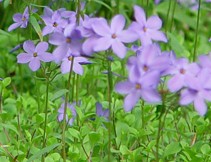 Creeping phlox is an herbaceous perennial native to southeastern US where it grows in the woodlands and moist areas of the Appalachian Mountains. It forms large mats of low growing evergreen foliage that are topped by loose six inch wide clusters of blue, lavender, white or pink flowers in spring. The flowers are fragrant and have rounded unnotched petals around a yellow center. They are about an inch across and are carried on stems six to twelve inches tall. The flowers are an important source of nectar for hummingbirds and swallowtail butterflies. The deep green leaves are ovate to round and differ in size with the ones on the creeping sterile stems measuring 1.2-1.8 inches long and those of the erect flowering stem measuring .72 inches. Creeping phlox is an excellent choice for a woodland garden and can be used as a groundcover. If it likes the site it well readily self-sow.
Creeping phlox is an herbaceous perennial native to southeastern US where it grows in the woodlands and moist areas of the Appalachian Mountains. It forms large mats of low growing evergreen foliage that are topped by loose six inch wide clusters of blue, lavender, white or pink flowers in spring. The flowers are fragrant and have rounded unnotched petals around a yellow center. They are about an inch across and are carried on stems six to twelve inches tall. The flowers are an important source of nectar for hummingbirds and swallowtail butterflies. The deep green leaves are ovate to round and differ in size with the ones on the creeping sterile stems measuring 1.2-1.8 inches long and those of the erect flowering stem measuring .72 inches. Creeping phlox is an excellent choice for a woodland garden and can be used as a groundcover. If it likes the site it well readily self-sow.
Type: Herbaceous perennial
Bloom: Loose clusters of lilac, purple, pink, white or blue flowers with yellow centers in spring
Size: Mat of foliage 3” H; flowering stems 6-8” H
Light: Part shade; tolerates more sun if moisture available.
Soil: Humusy, evenly moist, well-drained, slightly acidic, but tolerates less
Hardiness: Zones 4-8
Care: Remove flowering stems after blooming
Pests and Diseases: Powdery mildew, spider mites, slugs
Propagation: Basal cuttings in spring, root cuttings in early autumn or winter, seed
Companion Plants: Spring blooming woodland plants such as Aquilegia Canadensis, Tiarella cordifolia, Trillium luteum, Trillium flexipes, Sanguinaria Canadensis, ferns
Outstanding Selections:
‘Bruce’s White’
‘Chattahoochee’ (sky blue)